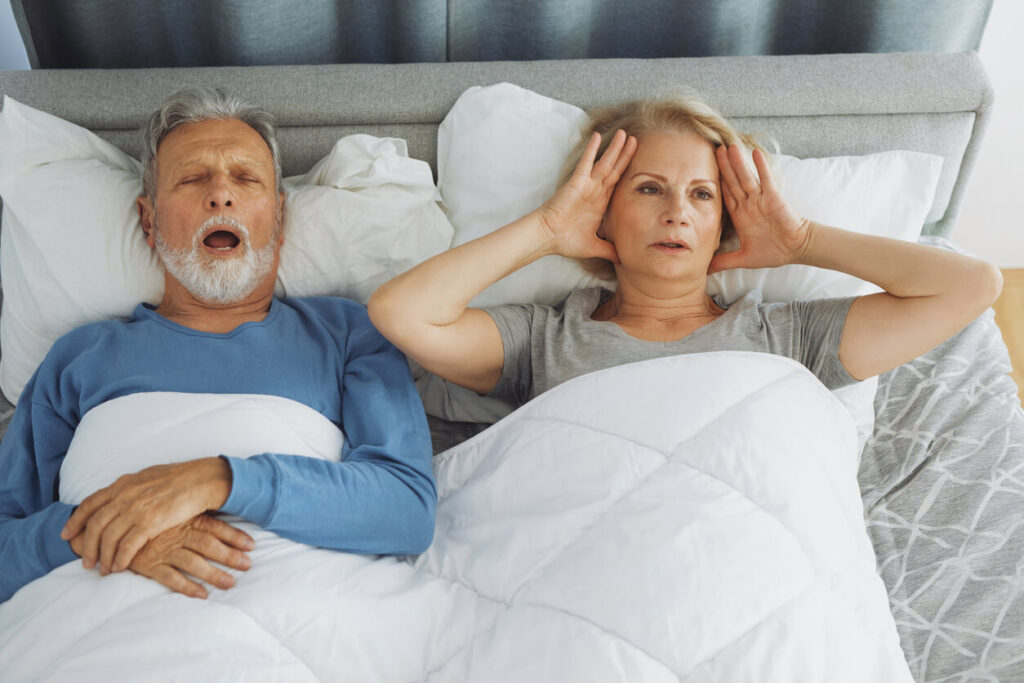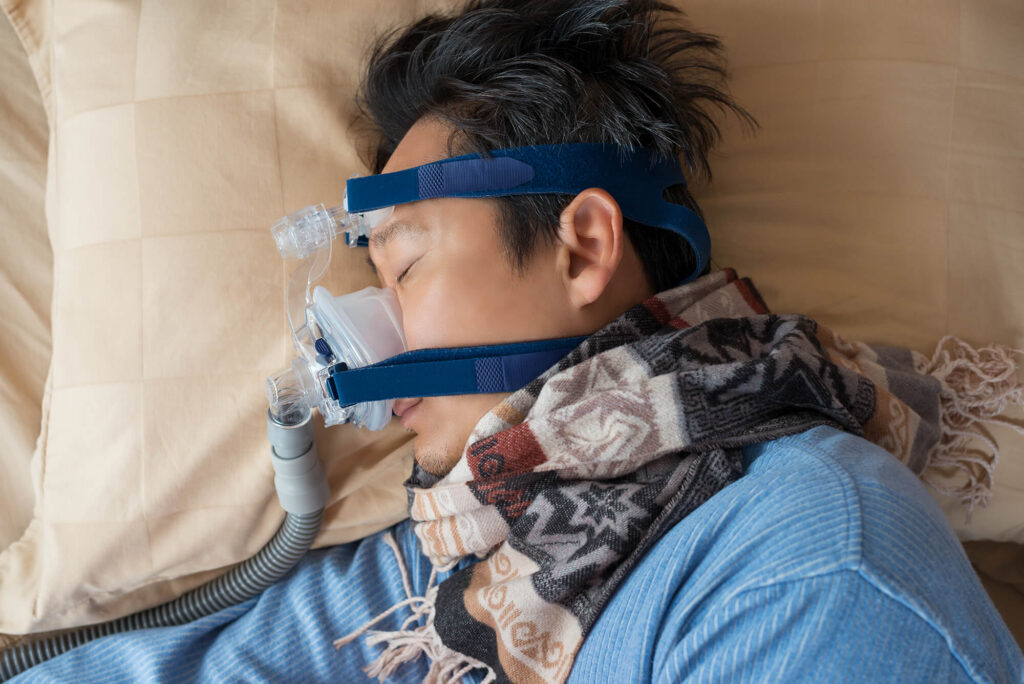Obstructive sleep apnea (OSA) is a sleeping disorder characterized by the repeated closure of the upper airway. It is the most frequent respiratory issue associated with sleep.
OSA develops when the muscles that support your throat’s soft tissues, such as your tongue and soft palate, relax and need sleep apnea treatment. This disorder causes your airway to narrow or possibly close, cutting off your breathing for a brief period.
Apnea or apneic episodes are periods when breathing ceases altogether. Air should normally flow smoothly from the mouth and nose into the lungs, especially during sleeping. During an apnea, the usual flow of air is continuously interrupted throughout the night in OSA.
Related: Does Sleep Apnea Affect Women?
Although OSA is most common in older men, it can affect anyone, even toddlers. Following menopause, the incidence climbs to the point where the rates in men and postmenopausal women are comparable.
Snoring is frequently connected with OSA, especially if it is punctuated by periods of stillness. Airflow squeezing through the constricted airway space causes snoring.
It is crucial to realize that snoring does not always signal a potentially serious condition, and not everyone who snores has OSA.

Effects of Obstructive Sleep Apnea
Untreated OSA can lead to major health issues such as:
- Elevated blood pressure (hypertension)
- Cardiovascular disease
- Stroke
- Diabetes
- Atrioventricular fibrillation (abnormal heart rhythm)
- Hypertension of the lungs
You can avoid complications with proper diagnosis and treatment.
Obstructive Sleep Apnea Symptoms
The majority of OSA patients reports daytime tiredness. OSA results in episodes of decreased oxygen delivery to the brain and other regions of the body, resulting in poor sleep quality. This causes tiredness during the day and a lack of clarity in the morning.
Those who share beds with OSA patients may experience the following symptoms:
- Heavy snoring
- Recurring awakenings during the night
- Gasping
- Snorting
- Choking
- Breathing disruptions while sleeping
- Children’s hyperactivity
- Headaches in the morning
- Increasing depression
- Dissatisfaction or Grumpiness
- Forgetfulness
- Drowsiness
- Poor job and academic performance
- Loss of sexual interest
People with sleep apnea are more likely to be involved in car accidents and workplace mishaps throughout the day. Treatment can assist in eliminating daytime drowsiness.

What Is the Cause of Obstructive Sleep Apnea?
OSA is connected with the following conditions:
- Obesity. Obese persons suffer from hypoventilation syndrome, a respiratory disease.
- Endocrine disorders such as hypothyroidism, acromegaly, and polycystic ovarian syndrome which might influence your breathing while you sleep
- Asthma, chronic obstructive pulmonary disease (COPD), and pulmonary fibrosis are examples of chronic lung diseases.
- Neuromuscular disorders, such as a stroke, can disrupt brain impulses to your chest muscles and airway.
- Failure of the heart or kidneys which can cause fluid to accumulate in the neck and clog the upper airway
Risk Elements
If you have physical traits that constrict your upper airway, you are more likely to develop OSA. OSA risk factors include:
- Obesity
- A lot of tonsils
- Men with a collar length of 17 inches or greater
- Women wearing collars measuring 16 inches or more
- A big tongue that can obstruct the airway
- Retrognathia is a condition in which your lower jaw is shorter than your upper jaw.
- A more readily collapsible palate or airway
- Smoking
- OSA in the family
How Do You Diagnose Sleep Apnea?
A comprehensive history and physical examination are required to diagnose sleep apnea. A history of daytime tiredness and snoring is crucial. Your doctor will examine your head and neck to look for any physical issues causing your sleep apnea. He may ask you to complete a questionnaire about your daytime tiredness, sleep habits, and sleep quality.
You may conduct the following test may be conducted.
Polysomnography (PSG)
You sleep overnight in a hospital or sleep center while attached to a range of monitoring devices that record physiologic characteristics during polysomnography. Patterns of physiologic abnormalities during sleep could suggest sleep-disordered breathing or several other sleep disorders. The PSG will assess the activity of various organ systems connected with sleep while you sleep. It could include:
The Electroencephalogram (EEG)
During an EMG, two electrodes go on your chin, one above and one below your jawline. Other electrodes are attached to the shins. The EMG electrodes detect the electrical activity generated during muscular movements. Muscle relaxation should take place when sleeping. When you sleep, the EMG detects when your muscles relax and move.
The Electrooculogram (EOM)
During the sleep study, a single lead ECG records electrical impulse from your heart to monitor your heart rate and rhythm.
Oximetry by Pulse
For this test, a pulse oximeter is clipped onto a thin region of your body with good blood flow, such as a fingertip or earlobe. The pulse oximeter measures the oxygen saturation level in your blood using a tiny emitter with red and infrared LEDs. This level may drop during apneic episodes.
Treating Obstructive Sleep Apnea
OSA treatment aims to ensure that airflow is not impeded while sleeping. The following are some treatment options:
Loss of weight
People with OSA who are also obese are frequently advised to lose weight and exercise. Although it may not result in complete remission, weight loss has been proven beneficial.
Continuous Positive Airway Pressure (CPAP)
The first line of treatment for OSA is continuous positive airway pressure (CPAP) therapy. It is delivered through a nighttime face mask.
Positive airflow is delivered gently through the face mask to keep the airways open at night. The positive airflow helps to keep the airways open.
CPAP is an extremely successful treatment for sleep apnea. However, an oral appliance is a viable option for positive airway pressure for persons with mild to severe OSA who do not benefit from CPAP therapy.
Bilevel Positive Airway Pressure (BPAP)
If CPAP therapy is ineffective, bilevel positive airway pressure (BPAP) machines are sometimes used to treat OSA. In reaction to your breathing, BPAP machines, also known as BiPAP machines, deliver two pressures: inhaled and exhaled. This means that the pressure fluctuates during inhalation and exhalation.
Sleeping on One’s Side
Because sleeping on your back (supine posture) might aggravate OSA in some people, positional therapy is used to teach you to sleep on your side. You can find all Healthline-approved products for side sleepers in our sleep shop.
Conclusion
You should always consult your doctor if you experience daytime sleepiness or consistently have trouble sleeping.
There are numerous therapy options for OSA to assist you to managing the symptoms. Your doctor will design a treatment plan incorporating lifestyle changes and other therapy.
